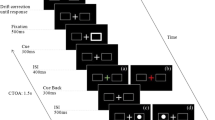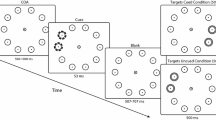Abstract
After presentation of a peripheral cue, facilitation at the cued location is followed by inhibition of return (IOR). It has been recently proposed that IOR may originate at different processing stages for manual and ocular responses, with manual IOR resulting from inhibited attentional orienting, and ocular IOR resulting form inhibited motor preparation. Contrary to this interpretation, we found an effect of target contrast on saccadic IOR. The effect of contrast decreased with increasing reaction times (RTs) for saccades, but not for manual key-press responses. This may have masked the effect of contrast on IOR with saccades in previous studies (Hunt and Kingstone in J Exp Psychol Hum Percept Perform 29:1068–1074, 2003) because only mean RTs were considered. We also found that background luminance strongly influenced the effects of gap and target contrast on IOR.



Similar content being viewed by others
Notes
To avoid ambiguities, we mostly refer to target luminance relative to background luminance (i.e., target contrast) instead of absolute luminance.
The SIMPLEX algorithm (MATLAB® function fminsearch, with default parameters) was used to find the best fitting ex-Gaussian cumulative distribution that minimized the squared sum of the residuals. The ex-Gaussian distribution is widely used as it usually offers a good fit of reaction times data (Heathcote et al. 1991; Luce 1991).
References
Abrams RA, Dobkin RS (1994) The gap effect and inhibition of return: interactive effects on eye movement latencies. Exp Brain Res 98:483–487
Abrams RA, Pratt J (2000) Oculocentric coding of inhibited eye movements to recently attended locations. J Exp Psychol Hum Percept Perform 26:776–788
Bekkering H, Pratt J, Abrams RA (1996) The gap effect for eye and hand movements. Percept Psychophys 58:628–635
Berlucchi G, Chelazzi L, Tassinari G (2000) Volitional covert orienting to a peripheral cue does not suppress cue-induced inhibition of return. J Cogn Neurosci 12:648–663
Briand KA, Larrison AL, Sereno AB (2000) Inhibition of return in manual and saccadic response systems. Percept Psychophys 62:1512–1524
Cao D, Zele AJ, Pokorny J (2007) Linking impulse response functions to reaction time: Rod and cone reaction time data and a computational model. Vis Res 47:1060–1074
Carpenter RH, Williams ML (1995) Neural computation of log likelihood in control of saccadic eye movements. Nature 377:59–62
Chelazzi L, Biscaldi M, Corbetta M, Peru A, Tassinari G, Berlucchi G (1995) Oculomotor activity and visual spatial attention. Behav Brain Res 71:81–88
Chichilnisky EJ, Kalmar RS (2002) Functional asymmetries in ON and OFF ganglion cells of primate retina. J Neurosci 22:2737–2747
Danziger S, Kingstone A (1999) Unmasking the inhibition of return phenomenon. Percept Psychophys 61:1024–1037
Deubel H, Schneider WX (1996) Saccade target selection and object recognition: evidence for a common attentional mechanism. Vision Res 36:1827–1837
Dorris MC, Munoz DP (1995) A neural correlate for the gap effect on saccadic reaction times in monkey. J Neurophysiol 73:2558–2562
Fecteau JH, Munoz DP (2006) Salience, relevance, and firing: a priority map for target selection. Trends Cogn Sci 10:382–390
Fischer MH, Pratt J, Neggers SF (2003) Inhibition of return and manual pointing movements. Percept Psychophys 65:379–387
Gibson BS, Egeth H (1994) Inhibition and disinhibition of return: evidence from temporal order judgments. Percept Psychophys 56:669–680
Godijn R, Theeuwes J (2002) Oculomotor capture and inhibition of return: evidence for an oculomotor suppression account of IOR. Psychol Res 66:234–246
Hawkins HL, Shafto MG, Richardson K (1988) Effects of target luminance and cue validity on the latency of visual detection. Percept Psychophys 44:484–492
Heathcote A, Popiel SJ, Mewhort DJK (1991) Analysis of response time distributions: an example using the stroop task. Psychol Bull 109:340–347
Hunt AR, Kingstone A (2003) Inhibition of return: dissociating attentional and oculomotor components. J Exp Psychol Hum Percept Perform 29:1068–1074
Ignashchenkova A, Dicke PW, Haarmeier T, Thier P (2004) Neuron-specific contribution of the superior colliculus to overt and covert shifts of attention. Nat Neurosci 7:56–64
Ivanoff J, Klein RM (2006) Inhibition of return: sensitivity and criterion as a function of response time. J Exp Psychol Hum Percept Perform 32:908–919
Kingstone A, Klein RM (1993a) Visual offsets facilitate saccadic latency: does predisengagement of visuospatial attention mediate this gap effect? J Exp Psychol Hum Percept Perform 19(6):1251–1265
Kingstone A, Klein RM (1993b) What are human express saccades? Percept Psychophys 54:260–273
Kingstone A, Pratt J (1999) Inhibition of return is composed of attentional and oculomotor processes. Percept Psychophys 61:1046–1054
Li CS, Lin SC (2002) Inhibition of return in temporal order saccades. Vision Res 42:2089–2093
Luce RD (1991) Response times: their role in inferring elementary mental organization. Oxford University Press, New York
Machado L, Rafal R (2004) Inhibition of return generated by voluntary saccades is independent of attentional momentum. Q J Exp Psychol A 57:789–796
Maylor EA (1985) Facilitatory and inhibitory components of orienting in visual space. In: Posner MI, Marin OSM (eds) Attention and performance XI. Erlbaum, Hillsdale, NJ, pp 189–203
Maylor EA, Hockey R (1985) Inhibitory component of externally controlled covert orienting in visual space. J Exp Psychol Hum Percept Perform 11:777–787
Murray IJ, Plainis S (2003) Contrast coding and magno/parvo segregation revealed in reaction time studies. Vis Res 43(25):2707–2719
Posner MI, Cohen Y (1984) Components of visual orienting. In: Bouma H, Bowhuis D (eds) Attention and performance X. Erlbaum, Hillsdale, NJ, pp 531–556
Pratt J, Neggers B (2008) Inhibition of return in single and dual tasks: examining saccadic, keypress, and pointing responses. Percept Psychophys 70:257–265
Pratt J, Lajonchere CM, Abrams RA (2006) Attentional modulation of the gap effect. Vis Res 46(16):2602–2607
Purpura K, Kaplan E, Shapley RM (1988) Background light and the contrast gain of primate P and M retinal ganglion cells. Proc Natl Acad Sci USA 85:4534–4537
Rafal RD, Calabresi PA, Brennan CW, Sciolto TK (1989) Saccade preparation inhibits reorienting to recently attended locations. J Exp Psychol Hum Percept Perform 15:673–685
Ratcliff R (1979) Group reaction time distributions and an analysis of distribution statistics. Psychol Bull 86:446–461
Reuter-Lorenz PA, Hughes HC, Fendrich R (1991) The reduction of saccadic latency by prior offset of the fixation point: an analysis of the gap effect. Percept Psychophys 49:167–175
Reuter-Lorenz PA, Jha AP, Rosenquist JN (1996) What is inhibited in inhibition of return? J Exp Psychol Hum Percept Perform 22:367–378
Ro T, Pratt J, Rafal RD (2000) Inhibition of return in saccadic eye movements. Exp Brain Res 130:264–268
Ro T, Farne A, Chang E (2003) Inhibition of return and the human frontal eye fields. Exp Brain Res 150:290–296
Rolfs M, Vitu F (2007) On the limited role of target onset in the gap task: support for the motor-preparation hypothesis. J Vis 7(10):7, 1–20.
Sapir A, Soroker N, Berger A, Henik A (1999) Inhibition of return in spatial attention: direct evidence for collicular generation. Nat Neurosci 2:1053–1054
Schiller PH, Malpeli JG (1977) Properties and tectal projections of monkey retinal ganglion cells. J Neurophysiol 40:428–445
Schiller PH, Malpeli JG, Schein SJ (1979) Composition of geniculostriate input ot superior colliculus of the rhesus monkey. J Neurophysiol 42:1124–1133
Schmidt WC (1996) Inhibition of return is not detected using illusory line motion. Percept Psychophys 58:883–898
Sheliga BM, Riggio L, Rizzolatti G (1994) Orienting of attention and eye movements. Exp Brain Res 98:507–522
Sheliga BM, Riggio L, Rizzolatti G (1995) Spatial attention and eye movements. Exp Brain Res 105:261–275
Shepherd M, Findlay JM, Hockey RJ (1986) The relationship between eye movements and spatial attention. Q J Exp Psychol A 38:475–491
Smith DT, Rorden C, Jackson SR (2004) Exogenous orienting of attention depends upon the ability to execute eye movements. Curr Biol 14:792–795
Souto D, Kerzel D (2009) Involuntary cueing effects during smooth pursuit: facilitation and inhibition of return in oculocentric coordinates. Exp Brain Res 192:25–31
Spalek TM, Hammad S (2004) Supporting the attentional momentum view of IOR: is attention biased to go right? Percept Psychophys 66:219–233
Sternberg S (1969) The discovery of processing stages: extensions of Donders’ method. Acta Psychol 30:276–315
Sumner P, Nachev P, Vora N, Husain M, Kennard C (2004) Distinct cortical and collicular mechanisms of inhibition of return revealed with S cone stimuli. Curr Biol 14:2259–2263
Sumner P, Nachev P, Castor-Perry S, Isenman H, Kennard C (2006) Which visual pathways cause fixation-related inhibition? J Neurophysiol 95:1527–1536
Taylor TL, Klein R (1998) On the causes and effects of inhibition of return. Psychonomic Bull Rev 5:625–643
Taylor TL, Klein RM (2000) Visual and motor effects in inhibition of return. J Exp Psychol Hum Percept Perform 26:1639–1656
Tipples J (2002) Eye gaze is not unique: automatic orienting in response to uninformative arrows. Psychon Bull Rev 9:314–318
Welsh TN, Pratt J (2006) Inhibition of return in cue-target and target–target tasks. Exp Brain Res 174:167–175
Acknowledgments
We would like to thank Caroline Dunand for running the experiments, Jillian Fecteau, Daniel T. Smith, Casimir Ludwig, Rosanne van Diepen, and especially two anonymous reviewers for their comments. D.K. and D.S. were supported by grant PDFM1-114417 from the Swiss National Science Foundation.
Author information
Authors and Affiliations
Corresponding author
Additional information
An erratum to this article can be found at http://dx.doi.org/10.1007/s00221-009-1911-5
Rights and permissions
About this article
Cite this article
Souto, D., Kerzel, D. Evidence for an attentional component in saccadic inhibition of return. Exp Brain Res 195, 531–540 (2009). https://doi.org/10.1007/s00221-009-1824-3
Received:
Accepted:
Published:
Issue Date:
DOI: https://doi.org/10.1007/s00221-009-1824-3




